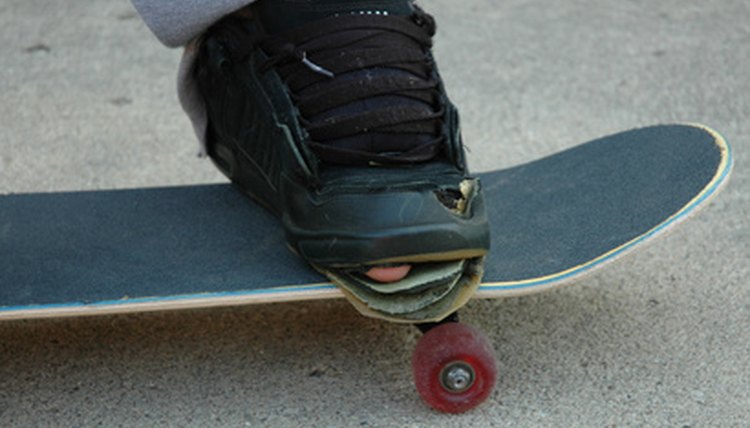How Is Skateboard Grip Tape Made?

Grip tape applied to the top of the skateboard deck creates traction between the rider's shoes and the board itself. Grip tape has a sandpaper-like construction commonly made from silicon carbide or a cheaper material known as aluminum oxide. Skateboard grip tape is now manufactured in a variety of colors, allowing skateboarders to customize their set-ups.
The Base
The manufacturer lays a large sheet of a screen-like polyester film onto a conveyor belt. The polyester film functions as the base of the grip tape. The screen-like design allows the grip tape to be pliable, making it easy to apply to the top of the skateboard deck. Tiny perforations produced in the polyester film allow for water and moisture to run off the grip tape. An automated machine applies epoxy to the top of the polyester film, creating a viscous surface.
The Coating
The abrasive mineral composition silicon carbide is sprayed on top of the polyester film to create the sandpaper-like texture of the grip tape. The cheaper version of silicon carbide known as aluminum oxide is used by the smaller manufacturers. Aluminum oxide is less expensive, but the grip wears out in a shorter amount of time.
Making It Stick
The grit-like silicon carbide dries on top of the polyester film with the use of a high-powered heat lamp. An automated machine applies an acrylic copolymer resin adhesive to the bottom of the polyester film, thus creating the sticky underside of the grip tape.
Backing Paper
A thick backing paper, applied over the copolymer resin adhesive, ensures that the sticky underside of the grip tape will not come into contact with other materials until the time of application.
Size
An automated machine cuts the massive sheets of polyester film with the silicon carbide top and the acrylic co-polymer resin bottom into 32 inch by 9 inch strips. This allows the skateboarder to purchase only one sheet of grip tape per board for around $10.
Writer Bio
Philip Foster has been writing professionally since 2010. His work has been featured in the literary-arts magazine "The PEEL" and the weekly newspaper "The Mountain Xpress." Foster is an expert in various extreme sports. He cooked in a restaurant that offered organic and vegetarian cuisine for over three years. Foster received a Bachelor of Arts in creative writing from Appalachian State University.
